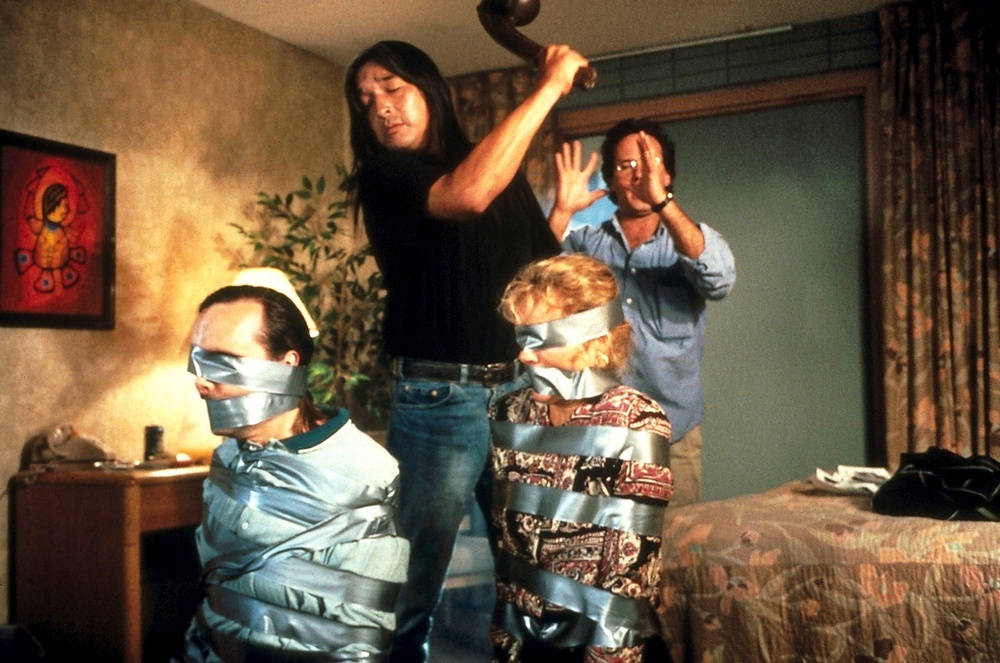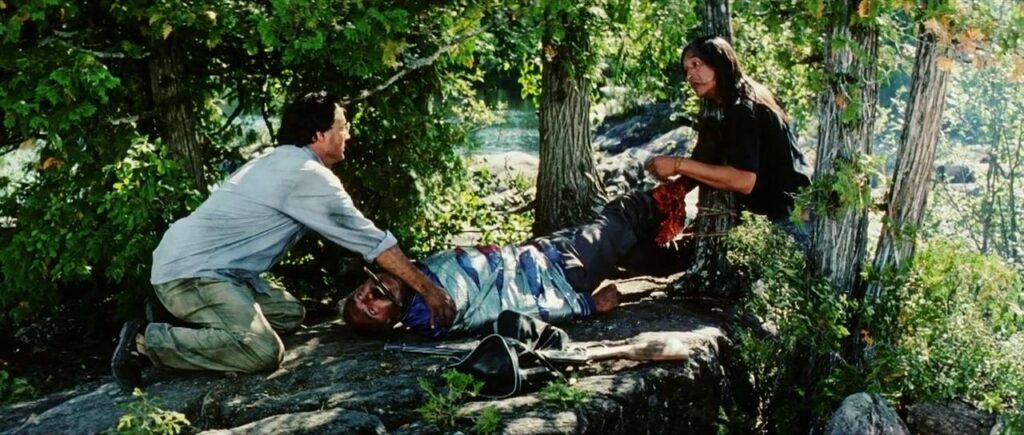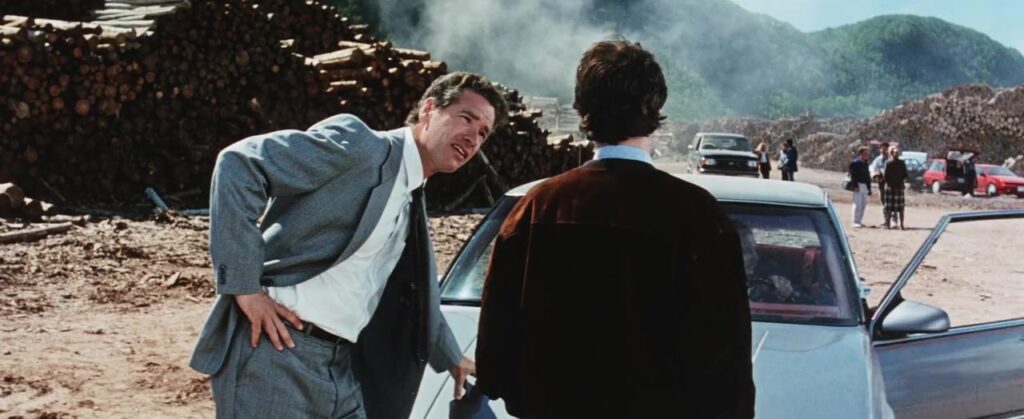“Do you still get paid when you lose?”
Last night I watched a film that I’d stumbled across in searching for some fresh Canadian cinema. I set out to find the more unearthed Canadian films for no more reason than my own curiosity and with little effort I came across Clearcut, the title of which I’d never even so much as heard uttered before.
A wildly gruesome tale of fleeting identities.
The film was made in 1991 and shot in Thunder Bay, Ontario although the location where the story is supposed to take place is not revealed, presumably to give it more universal appeal and as a comment that this was no singular set of events. It tells the story of a local logging company taking the land of a Native reservation to harvest their vast forest.
Directed by Ryszard Bugajski, a Polish director and renegade artist in his own right. Born into a Nazi occupied Warsaw, Bugaski would later go on to to be a member of the X Film Unit (Zespół Filmowy „X). The X Film Unit was Poland’s state run film production studio set up for the purpose of perpetuating Communist ideals. It was under this studio that Bugaski directed, The Interrogation in 1982. A film described as “the most anti-communist film in the history of the Polish People’s Republic” and was banned in the country for several years and led to the official termination of the X Film Unit. Bugaski would then leave Poland for Canada.
Needless to say, he certainly held the qualifications necessary for telling an underdog story. The screenplay was written by Robert Forsyth, adapted from the novel, A Dream Like Mine by M.T. Kelly and brought to life with tender and thoughtful cinematography by François Protat. The film stars Graham Greene, Floyd Red Crow Westerman, Ron Lea and Michael Hogan.
Clearcut opens with Peter McGuire (Ron Lea), the lawyer representing the Native communities’ case against the mill flying into the isolated territory as an escalating confrontation ensues between them, the police and the logger’s bulldozers. The case to keep the land protected has just been lost and the bulldozers are closing in along with some heartless press, skulking all about.
McGuire returns to salvage some hope within the community by relaying to them that he will file for an appeal. However when speaking privately with Wilf (Floyd Red Crow Westerman), the communities elder and leader, he confides the bleak reality of the pointless appeal. Wilf appears calm and hopeful, as the stoic elder one would expect saying, “It’s just a long battle, we haven’t won yet.” McGuire is not so sure and more so is enraged by the disparities of the legal system saying, “The world is turning to shit. I feel like somebody has to pay, somebody has to hurt. People like me have done no good for you. I have failed you.” Wilf stumps the young lawyer by replying, “Who do you feel bad for? Us or yourself?”
The two then go into a sweat lodge and beforehand Wilf asks McGuire to think about what he really wants out of all this. The sweet lodge brings on hallucinations of blood running down the trees and across the forest floor and McGuire comes out exhausted and confused.
Enter Arthur (Graham Greene) a Native about the age of McGuire who carries with him a perplexing aura. He’s far more literal and bombastic than Wilf yet he retains a mystique that is all of his own. He takes McGuire on a boat ride and leads him back to the hotel where he is staying. It is there that things begin to escalate for McGuire and all those that he is associated with, at least by Arthur’s account. The press are tied up and abandoned and the mill’s owner, Bud Rickets (Paul Hogan) is kidnapped and taken deep into the forest with which he plans to clearcut.
The story delves into a violent odyssey that deals with race, culture, pacifism, colonialism and the relationship we have to our environment. What’s admirable about the film is its approach to the complexity of these issues. It’s not a black and white take on any particular issue but an amoebas-like narrative that weaves in and out of some grey morality.

Each character is presented with some sympathy, including Rickets who could have easily been portrayed as a one-dimensional villain by a less courageous filmmaker. Even he is a given a moment to express his rationale behind the land purchase and the greater benefits of the mill with a certain charisma and pioneer charm. At one point while reflecting on Arthur, Rickets sees the two as more similar than he and McGuire by nature of their personality, despite his racial prejudice, “He’s a man of action our Arthur, he and I understand each other. I’m not sure where you fit. Making your decisions so….conscientiously.”
McGuire, the Torontonian lawyer represents the civilized white man, more liberal and empathetic to the mistreatment of Native Canadians and he is also portrayed with originality. Not just some strait-laced, by the book wimp who’s afraid of the wilderness, or getting his hands dirty. He’s sincerely interested in the culture he’s attempting to help preserve by fighting within the system.
Wilf, the community’s elder, is perhaps the most cliched character of the four however his peaceful nature and pacifistic approach are marred by his willingness to allow Arthur’s violent rampage and remain unbothered.
Arthur is a far cry from the stereotypical Hollywood Indian who sits cross-legged and smokes a peace-pipe. He wears a black t-shirt and jeans, white Nike shoes and wields a large factory-made hunting knife. His desires for vigilante justice are certainly understood, but ultimately all violence is the same at the end of the day. One’s natural reaction is to wince at the sight of blood, regardless of who it streams from.
The film takes on difficult subject matter and many subjects that continue to remain undiscussed in the public Canadian discourse with this kind of complexity. It is unclear to me just why exactly, the film remains relatively unknown in Canada although one theory suggests that it could have been due to its release being less than a year after the Oka Crisis.
The Oka Crisis also known as the Kanesatake Resistance was a land dispute between the Mohawk people and township of Oka, Quebec.
On March 11, 1990, the Mohawk people began to protest a court decision which allowed for the expansion of a local golf course that had been a point of contention since its initial building in 1959 as it bordered a Mohawk burial ground that was in use. The Mohawk filed suit against the development at the time but lost and further construction began on a parking lot and golf greens adjacent to their cemetery.
In 1977, an official land claim was filed with the federal Office of Native Claims regarding the land but the claim was eventually rejected in 1986 on the basis that it failed to meet several key legal aspects of the criteria.
In 1989, the Club de golf d’Oka announced plans to expand the course by another nine holes with no environmental or historical preservation review undertaken following the land claim rejection. Protests by the Mohawk and many of Oka’s townspeople led to some postponement of the development. There were also concerns coming from Quebec’s Minister of Environment however Jean Ouellette, the mayor of Oka at the time eventually won out and began clearcutting in 1990 with the additional plan to construct 60 condominiums as well.
A barricade was set up by protesters on July 11, 1990 and the standoff lasted a total of 77 days until coming to a head with a gun battle involving hundreds of protesters and Canadian military on September 26, resulting in two fatalities.
It was the first highly-publicized conflict between First Nations and the Canadian government of the late 20th century, spawning several documentaries and books. Some argued that the violence that occurred in Oka and the violence portrayed in the recently released thereafter film Clearcut, would send an inappropriate message to the masses. Perhaps, but time has certainly served the film well. It’s just as poignant and relative today as it was then, if not more, as First Nations reserves across the country continue to struggle and get slapped around by the state and their affiliates.

Clearcut is a brave and unique film which attempts to tackle its own curiosity unapologetically. The film explores with ease the brutish nature of the ever-hungry corporate world and the violent streak that runs through the heart of each and every individual with poised and understated acting. The stylish and disorienting climax will leave you questioning many aspects of yourself, our history and the nation’s current identity. One message of the film that does remain clearcut is that we are far closer to the barbarism we’d like to think we’ve long since left behind us.
